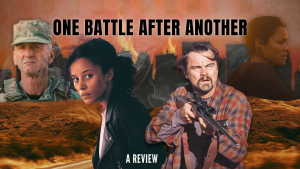Looking into the past…
June 10, 2009
Art buffs and history scholars rubbed shoulders with curious students at a two-day American Indian History Symposium called “Guardians of Knowledge – Guardians of the Past” in the University Union on Thursday.
Traditional Native American arts and crafts were for sale in the Redwood Room and students browsed through books written by event speakers in Hinde Auditorium. The event coincided with the debut of an American Indian artworks exhibit in the Anthropology museum titled “Envisioning American Indian Histories: Art, Object, Text.”
The exhibit features artwork supplied by students and faculty, including a painting by former director of Native American Studies Frank LaPena. “The Guardians” a mixed-media piece, has three dark figures grouped together against a blue-green backdrop with a red spiral and swiftly painted animals above them. To the untrained eye, it looks like it might be a depiction of animals guarding the figures’ grave site, but LaPena said that it is instead an abstract work about the “guardians of the natural world” and natural energy.
“The natural world reflects us as human beings?moving through nature,” LaPena said.
“Abstract art is built on real concepts?the ancients were doing the same – making conceptual art.”
LaPena said his inspiration for the painting after a trip to the Southwest with his friends. An artist friend was in the process of painting a depiction of an ancient creature depicted by native peoples.
When a mutual friend of her and LaPena’s told her that he knew the location of a certain site of petroglyphs depicting an ancient creature that she was painting, she asked LaPena to come along for the journey. They traveled to New Mexico and Utah to see the petroglyphs, which were anywhere from 5,000 to 10,000 years old.
Terri Castaneda, museum director and exhibit curator, said the exhibit “highlights the multiplicity of these forms and celebrates the many voices, narratives, and strands of individual and collective memory that give texture and meaning to American Indian histories.”
She said she hopes people come away with the understanding the exhibit explores multiple cultural histories and that there is more than one story to tell when trying to understand Native American history. She said that using student and faculty objects gives the show a more personal touch and makes the experience more meaningful.
Vanessa Esquivido, junior anthropology major, is an enrolled member of the Nor Rel Muk Wintu tribe. Esquivido contributed to the exhibit with sentimental pictures and objects belonging to her family.
“I didn’t put up any art, but there was a picture of my great-grandmother Amy Hailstone, and a picture of my grandfather Hugh Dail Upton, a.k.a. ‘Pete’, who are also both Nor Rel Muk Wintu.”
LaPena said the Wintun people are not merely one tribe but have factions within, much like there are different groups of Christians. Those factions are nestled along northern California and include the Wintu around Shasta and Trinity counties, the Nomkalakki from south of Red Bluff to roughly south of Willow and the Patwin, found in the Bay Area and Yolo County.
Symposium coordinator Annette Reed said, “This has been a collaborative efforts by many sponsors and individuals. It is a true honor to have American Indian history scholars present at Sac State. It is a great opportunity for students, faculty, staff and community members to hear new scholarship in the field.”
Julia Baum can be reached at [email protected].






















































































































